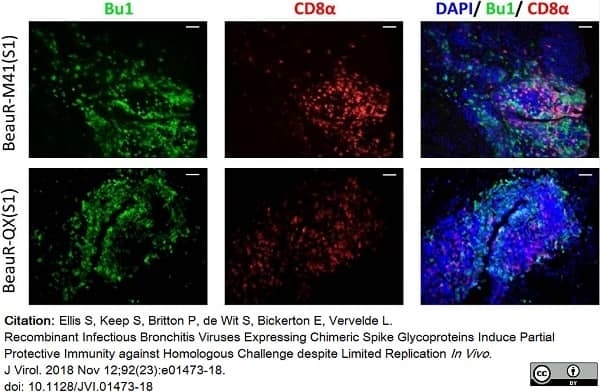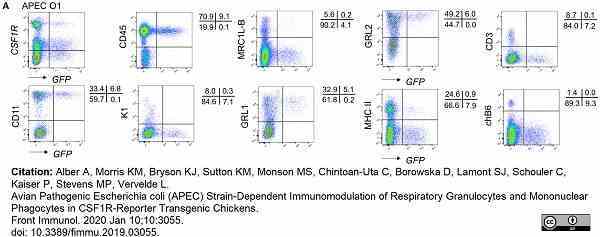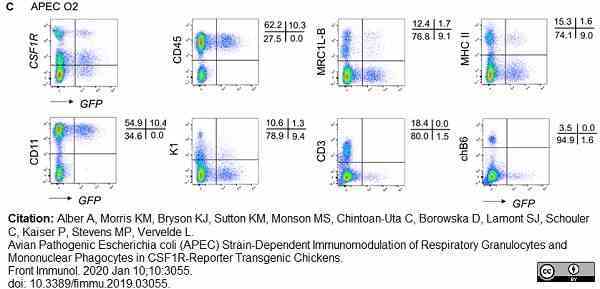Bu-1a/b antibody | AV20



Mouse anti Chicken Bu-1a/b
- Product Type
- Monoclonal Antibody
- Clone
- AV20
- Isotype
- IgG1
- Specificity
- Bu-1a/b
| Mouse anti Chicken Bu-1a/b antibody, clone AV20 recognizes Chicken Bu-1a/b, also known as chB6, a type 1 transmembrane protein. Bu-1 is a product of two alleles, Bu-1a ad Bu-1b, clone AV20 recognises both alleles. The Bu-1 antigen is expressed by chicken B-cells throughout most of their development and by a subset of monocytes and macrophages. The antigen is absent from erythrocytes, granulocytes and thrombocytes. In addition to clone AV20, clone L22 that recognises Bu-1a but not Bu-1b is available. |
- Target Species
- Chicken
- Species Cross-Reactivity
-
Target Species Cross Reactivity Quail Turkey Guinea Fowl - N.B. Antibody reactivity and working conditions may vary between species.
- Product Form
- Purified IgG - liquid
- Preparation
- Purified IgG prepared by ion exchange chromatography from tissue culture supernatant
- Buffer Solution
- Borate buffered saline
- Preservative Stabilisers
- <0.1% Sodium Azide (NaN3)
- Immunogen
- Bursal cells from day old H.B15 (Bu-1a/b) chickens.
- Approx. Protein Concentrations
- IgG concentration 0.5mg/ml
- Regulatory
- For research purposes only
- Guarantee
- 12 months from date of despatch
Avoid repeated freezing and thawing as this may denature the antibody. Storage in frost-free freezers is not recommended.
| Application Name | Verified | Min Dilution | Max Dilution |
|---|---|---|---|
| Flow Cytometry | |||
| Immunohistology - Frozen | |||
| Immunoprecipitation |
- Flow Cytometry
- Use 10ul of the suggested working dilution to label 1x106 cells in 100ul.
| Description | Product Code | Applications | Pack Size | List Price | Your Price | Quantity | |
|---|---|---|---|---|---|---|---|
| Goat anti Mouse IgG (H/L):FITC (Multi Species Adsorbed) | STAR117F | F | 0.5 mg |
|
Log in | ||
| List Price | Your Price | ||||||
|
|
Log in | ||||||
| Description | Goat anti Mouse IgG (H/L):FITC (Multi Species Adsorbed) | ||||||
| Goat anti Mouse IgG (H/L):HRP (Multi Species Adsorbed) | STAR117P | C E WB | 0.5 mg |
|
Log in | ||
| List Price | Your Price | ||||||
|
|
Log in | ||||||
| Description | Goat anti Mouse IgG (H/L):HRP (Multi Species Adsorbed) | ||||||
| Rabbit F(ab')2 anti Mouse IgG:RPE | STAR12A | F | 1 ml |
|
Log in | ||
| List Price | Your Price | ||||||
|
|
Log in | ||||||
| Description | Rabbit F(ab')2 anti Mouse IgG:RPE | ||||||
| Rabbit F(ab')2 anti Mouse IgG:FITC | STAR9B | F | 1 mg |
|
Log in | ||
| List Price | Your Price | ||||||
|
|
Log in | ||||||
| Description | Rabbit F(ab')2 anti Mouse IgG:FITC | ||||||
Source Reference
-
Rothwell, C.J. et al. (1996) Identification of chicken Bu-1 alloantigens using the monoclonal antibody AV20.
Vet Immunol Immunopathol. 55 (1-3): 225-34.
References for Bu-1a/b antibody
-
Tregaskes, C.A. et al. (1996) Chicken B-cell marker chB6 (Bu-1) is a highly glycosylated protein of unique structure.
Immunogenetics. 44 (3): 212-7. -
Baigent, S.J. & Davison, T.F. (1999) Development and composition of lymphoid lesions in the spleens of Marek's disease virus-infected chickens: Association with virus spread and the pathogenesis of Marek's disease.
Avian Pathol. 28 (3): 287-300. -
Barrow, A.D. et al. (2003) Infection of macrophages by a lymphotropic herpesvirus: a new tropism for Marek's disease virus.
J Gen Virol. 84 (Pt 10): 2635-45. -
Tregaskes, C.A. et al. (2005) Conservation of biological properties of the CD40 ligand, CD154 in a non-mammalian vertebrate.
Dev Comp Immunol. 29 (4): 361-74. -
Igyár;rtó BZ et al. (2008) Identification of the avian B-cell-specific Bu-1 alloantigen by a novel monoclonal antibody.
Poult Sci. 87 (2): 351-5. -
Meyerhoff, R.R. et al. (2012) Comprehensive analysis of commercially available mouse antichicken monoclonal antibodies for cross-reactivity with peripheral blood leukocytes from commercial turkeys.
Poult Sci. 91 (2): 383-92. -
Balic, A. et al. (2014) Visualisation of chicken macrophages using transgenic reporter genes: insights into the development of the avian macrophage lineage.
Development. 141: 3255-65. -
Sadeyen, J.R. et al. (2015) A cyclophosphamide-sensitive cell compartment is essential for homologous protection conferred by licensed vaccines for the control of avian pathogenic Escherichia coli. in chickens.
Vaccine. 33 (31): 3624-7.
View The Latest Product References
-
Schermuly, J. et al. (2015) In vitro model for lytic replication, latency, and transformation of an oncogenic alphaherpesvirus.
Proc Natl Acad Sci U S A. 112 (23): 7279-84. -
Ellis, S. et al. (2018) Recombinant Infectious Bronchitis Viruses Expressing Chimeric Spike Glycoproteins Induce Partial Protective Immunity against Homologous Challenge despite Limited Replication In Vivo.
J Virol.92 (23): e01473-18. -
Alber, A. et al. (2019) Avian Pathogenic Escherichia coli (APEC) Strain-Dependent Immunomodulation of Respiratory Granulocytes and Mononuclear Phagocytes in CSF1R-Reporter Transgenic Chickens.
Front Immunol. 10: 3055.
- Synonyms
- Bursal Antigen 1 A/B
- RRID
- AB_10720221
- UniProt
- Q90747
- Q90746
MCA5764
If you cannot find the batch/lot you are looking for please contact our technical support team for assistance.
Please Note: All Products are "FOR RESEARCH PURPOSES ONLY"
View all Anti-Chicken ProductsAlways be the first to know.
When we launch new products and resources to help you achieve more in the lab.
Yes, sign me up

